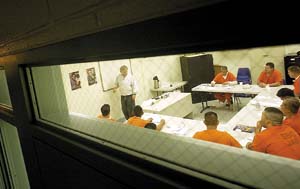
On a February night in 2002, Xochil Veronica Ruiz and a friend
assaulted another woman in the driveway of her Hollister
residence.
On a February night in 2002, Xochil Veronica Ruiz and a friend assaulted another woman in the driveway of her Hollister residence.
She was convicted of a misdemeanor battery charge in 2004, and ordered to serve 20 days in county jail and complete 26 weeks of an anger management course. Ruiz received two years of probation, but would begin a cycle of violating its terms.
Frustrated and overwhelmed with life, Ruiz left California. She went to Texas and Mexico before turning herself in.
On Aug. 8, a judge sentenced Ruiz to six months in jail. Now 28 years old, Ruiz said Wednesday that this stint in jail has been different.
Ruiz hopes a new anger management class offered in the San Benito County Jail will help her control what may have landed her behind bars in the first place more than five years ago.
“I’m finding out how to react,” Ruiz said. “I’m going to learn how to walk away.”
Nelda Escamilla, a domestic violence and anger management facilitator, has been teaching anger management classes for probationers for five years. Escamilla began holding sessions at the jail Oct. 1.
Escamilla helps inmates recognize their patterns of behavior, learn how to break free and communicate better with those around them. She teaches the course in both English and Spanish.
“No. 1 in any situation is communication,” Escamilla said. “It’s first and foremost.”
As Escamilla approached the window of a jail classroom Wednesday, several men sitting in the morning GED class smiled when they saw her and waved frantically.
The men are in her domestic violence and anger management class, and Escamilla is helping them look inward and realize what is causing their violent outbursts.
Juan Garcia, 41, is serving a 120-day jail sentence for domestic violence. Fred Zapata, 52, is serving 75 days for the same.
“Mrs. Escamilla has become a part of my family with the help she’s given me,” Garcia said.
Garcia and Zapata hope to use the tools learned in her class – and keep the anger from resurfacing that sent them away. In addition to the GED program and anger management course, Zapata goes to bible study and alcoholics anonymous.
Escamilla said she tries to impart to these men her own experiences as a victim of domestic violence.
“My goal is to see less victims,” Escamilla said.
Zapata said Escamilla has a way of showing the characteristics within him that he cannot see himself.
“She made me think about a lot of things that I’ve never thought about before,” Zapata said.
Larry Sweeney, a Gavilan Community College professor who taught Zapata and Garcia’s GED class Wednesday, has worked in the jail for three months.
The time he has spent teaching inmates has humanized them, Sweeney said. They are no longer a statistic to Sweeney. They’re real people.
“These men have families and dreams for themselves,” Sweeney said, “just like I have a family and dreams.”
Sweeney said the inmates in his class need an education so they can have jobs on the outside and stay out of trouble.
“It seems like the United States is warehousing the poor in its prisons and jails,” Sweeney said. “But programs like this may help to change that trend.”
San Benito County Undersheriff Pat Turturici, who ran the San Benito County Jail and has walked its halls for the better part of his adult life, said he has seen three generations of some men incarcerated in the jail.
“The recidivism rate is through the roof,” Turturici said. “We keep seeing the same people over and over again.”
Turturici said the programs are part of a larger effort to emphasize rehabilitation in California’s state prison system.
“We don’t want to be a county that just locks them up and forgets about them,” Turturici said.
More than 80 percent of juveniles in the system have parents in the system, Escamilla said.
Escamilla said she believes there is hope to turn these lives around.
“Otherwise I wouldn’t be here,” Escamilla said.
And inmates like Ruiz believe the hope is there, too.
Abandoned at age 8, Ruiz spent her adolescence in foster homes. She said her violent acts are a result of low self-esteem.
But as she grows older and has access to the programs at the jail, Ruiz feels less anxious. When she is released, Ruiz will be enrolled in classes at Gavilan Community College.
“They’re giving us something to look forward to out there,” Ruiz said.








